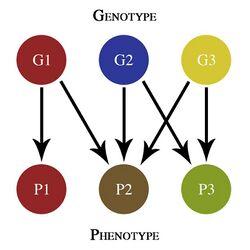Biology:Genotype–phenotype map
From HandWiki
The genotype–phenotype map is a conceptual model in genetic architecture. Coined in a 1991 paper by Pere Alberch,[1] it models the interdependency of genotype (an organism's full hereditary information) with phenotype (an organism's actual observed properties).
Application
The map visualises a relationship between genotype & phenotype which, crucially:[2]
- is of greater complexity than a straightforward one-to-one mapping of genotype to/from phenotype.
- accommodates a parameter space, along which at different points a given phenotype is said to be more or less stable.
- accommodates transformational boundaries in the parameter space, which divide phenotype states from one another.
- accounts for different polymorphism and/or polyphenism in populations, depending on their area of parameter space they occupy.
References
- ↑ Alberch, Pere (1991). "From genes to phenotype: dynamical systems and evolvability". Genetica 84 (1): 5–11. doi:10.1007/BF00123979. PMID 1874440. https://link.springer.com/article/10.1007/BF00123979. Retrieved 18 October 2020.
- ↑ Pigliucci, Massimo (2010). "Genotype–phenotype mapping and the end of the 'genes as blueprint' metaphor". Philosophical Transactions of the Royal Society of London. Series B, Biological Sciences 365 (1540): 557–566. doi:10.1098/rstb.2009.0241. PMID 20083632.
 |


